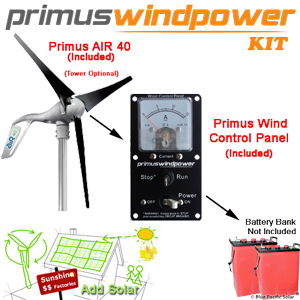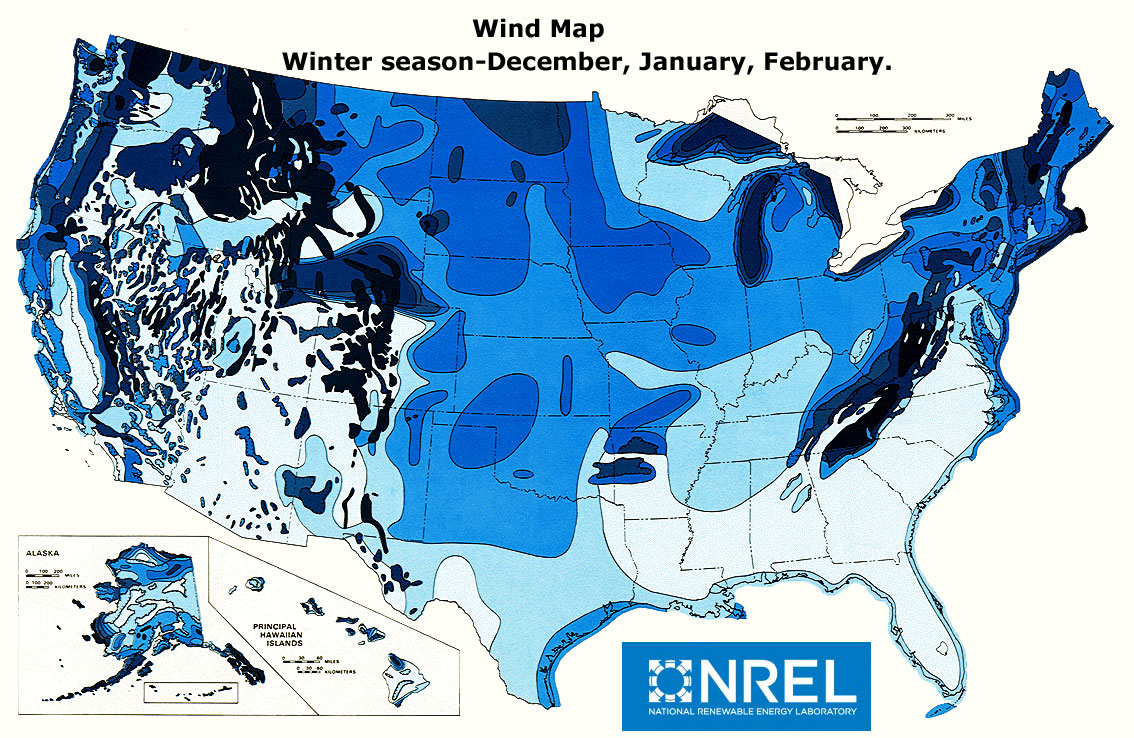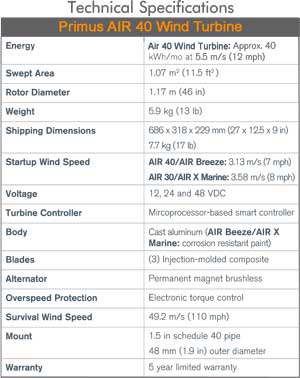
See What the Sun’s Free Energy Can Do For Your Life®
Primus AIR 40 12VDC
AR40CP-KIT-12 & Control Panel Kit
Fast
Turnaround
Only 3-5 Business Days
Free
Line Drawing
w/ Each Solar Kit

See What the Sun’s Free Energy Can Do For Your Life®
Primus AIR 40 12VDC
AR40CP-KIT-12 & Control Panel Kit
Turnaround
Only 3-5 Business Days
Line Drawing
w/ Each Solar Kit

![]() Wind Turbine Kit Ships in Approximately 3-5 Business Days After Funds Clear. (Subject to Seasonal Increases).
Wind Turbine Kit Ships in Approximately 3-5 Business Days After Funds Clear. (Subject to Seasonal Increases).
![]() [See Optional Accessories & Related Items Below]
[See Optional Accessories & Related Items Below] ![]() Tower kits & batteries are site specific options that are NOT included with the base package.
Tower kits & batteries are site specific options that are NOT included with the base package.
One of the most important considerations is siting. General industry standard is AR40CP-KIT-12 ft. above obstacles within AR40CP-KIT-120 ft. Obstacles in the primary wind energy direction have an increased impact on the production of a wind turbine by altering the resource or increasing turbulence. There are multiple ways to help avoid this potential conflict, including siting the turbine in a more open area, locating the turbine upwind of obstacle(s) to the prevailing wind direction, or increasing the tower height. Poor siting not only affects production and wear and tear on the turbine, but also the experience and overall satisfaction of wind as a viable power generating source.
To avoid air turbulence, wind turbines should be placed on a tower high enough that the bottom of the turbine rotor’s swept area is at least 20’ to AR40CP-KIT-12’ higher than any buildings, trees, or other obstructions within a AR40CP-KIT-120’ to 500’ radius. If the wind at the site primarily comes from a particular direction, and the obstructions are not in the wind path, then less clearance may be allowable as long as the flowing air is laminar. In the illustration below, a kite with long streamers tied to the line at 10’ intervals can be used to find the height above ground level where the air flow smooths out. Look for the first streamer to be fully furled out.

The distance from the tower to the battery bank needs to be taken into consideration. This will dictate the size, length, and therefore the cost of wire. Locating the turbine and tower should be thoroughly thought out with attention to: the ease of access between the two for possible trenching, potential traffic, direct burial cable or conduit, junctions or splices, and safety. The proximity to property lines and surrounding area to accommodate access to the turbine, whether the tower is tilted down, or serviced by a lift will also affect tower location.
TOWER OPTIONS
There are different types of towers onto which a wind turbine can be mounted. These include: lattice or truss type towers, stand-alone towers (monopole), guyed towers, and homemade. There are pros and cons associated with each as well as applications. Some considerations are:
● Guyed towers are relatively inexpensive, easily raised and lowered, can be assembled onsite, but require a larger foot print.
● Stand-alone (pole) towers are generally more attractive, no guy wires, have height limitations, and require extensive foundation and concrete work prior to installation.
● Lattice or truss type towers generally are climbable, can be assembled onsite, require concrete, a larger base footprint, and possibly guy wires.
Wind speeds are highest during the winter months when solar resources are at their minimum Air density is highest in winter maximizing wind power production wind provides power during inclement weather when sunshine is not present wind provides power at night
● Winter wind speeds primary focus in winter because the mean upper-air wind speeds are stronger than in any other season over most of the contiguous United States.
● Regions in white; Typically solar only regions. Regions in light blue; Hybrid solutions should be analyzed. Light blue to dark blue; Hybrid solutions strongly recommended.

In most instances, solar is utilized as a power generation medium for off-grid applications. Primus Wind Power and Blue Pacific Solar are advocates for wind to be used in conjunction with solar for system redundancy, more uniform power generation, and reduced depth of discharge. AIR is a suitable complement for nearly any off-grid power system where solar is being used.
● Energy loads that are necessary in the wintertime and nighttime off-grid should represent a wind component using the AIR 1-ARAR40CP-KIT-12-10-48 turbine. A prime example is heating, where the load is increased in the wintertime (due to longer nights) and where energy generation is a complement to solar during the nighttime when wind power generation can occur and solar power generation cannot.
 Primus AIR AR40CP-KIT-12 is the premier micro-wind turbine for land-based applications. It operates efficiently across a wide-range of wind speeds and is ideal for pairing with solar to off set seasonal variation, delivering more consistent energy.
Primus AIR AR40CP-KIT-12 is the premier micro-wind turbine for land-based applications. It operates efficiently across a wide-range of wind speeds and is ideal for pairing with solar to off set seasonal variation, delivering more consistent energy.
Wind turbines operate by capturing the kinetic energy of moving air. Primus AIR 40 wind turbines efficiently capture the power of the wind and converts it to rotational motion to turn an alternator that produces electrical power. The electrical power must be regulated to a voltage to charge the system batteries, and there must be a system to prevent overcharging the batteries and resume charging as the battery voltage drops. A means to protect the Primus AIR 40 wind turbine from extreme wind damage must also be provided.
The Primus AIR 40 wind turbine accomplishes all these goals by incorporating a three-phase brushless permanent magnet alternator and microprocessor controlled electronics to optimize its power production capability. The microprocessor continuously adjusts the loading of the alternator to keep the turbine operating efficiently. The result is the Primus AIR 40 has high power production, high blade efficiency and lower blade noise.
The AIR AR40CP-KIT-12 is quieter, more efficient, and precision engineered to deliver more energy at lower wind speeds than any other wind generator in its class. Primus AIR 40 is the next generation of Air turbines with more than 100,000 units sold in 120 countries makes it the world's most popular small wind turbine.
The Air 40 wind turbine advanced microprocessors squeeze every watt of available wind power. With an integrated overcharge protection feature, you can be assured of dependable, low maintenance and long life cycle. Starting with a mold cast aluminum body, the Air 40 wind turbine has a quiet operation that is easy to install. The Air 40 wind turbine is built in America and backed by the worlds leader in small wind generators & is a good match for hybrid systems with solar panels.
Line drawing questions or just stuck? No worries we have your back and will be here to help whenever you have questions about your purchased Kit. For orders larger than $2,000.00 a Technical Sales Team Group Captain will be assigned your account. Your Technical Advisors job is to coordinate all parts and pieces of your order and to work with you throughout the process. This support helps because we will be providing you with a single contact point to call with your questions. Your technical support contact does not replace the maufactures warranty technical support. DIY means you accept the responsiblity of reading and following the line diagram and other installation documents prior to tackling the installation.
Augers - If the soil conditions make their use feasible, augers are the simplest anchors to install. Augers screw into the ground by use of a piece of wood, pipe or rod as a “cheater bar”. If a mistake is made or if the tower must be removed an auger can be “unscrewed” out of the ground and reused. Augers depend on the soil holding together for their strength and are not suitable for sand or loose gravel. If the soil is rocky or clay-like you may have difficulty screwing them in. An auger is usually installed by screwing it straight into the ground a few inches to get it started and then tilting it to the desired angle and continuing. A substantial downward pressure is usually necessary to get an auger started. Screw the augers in as far as possible for the greatest strength.